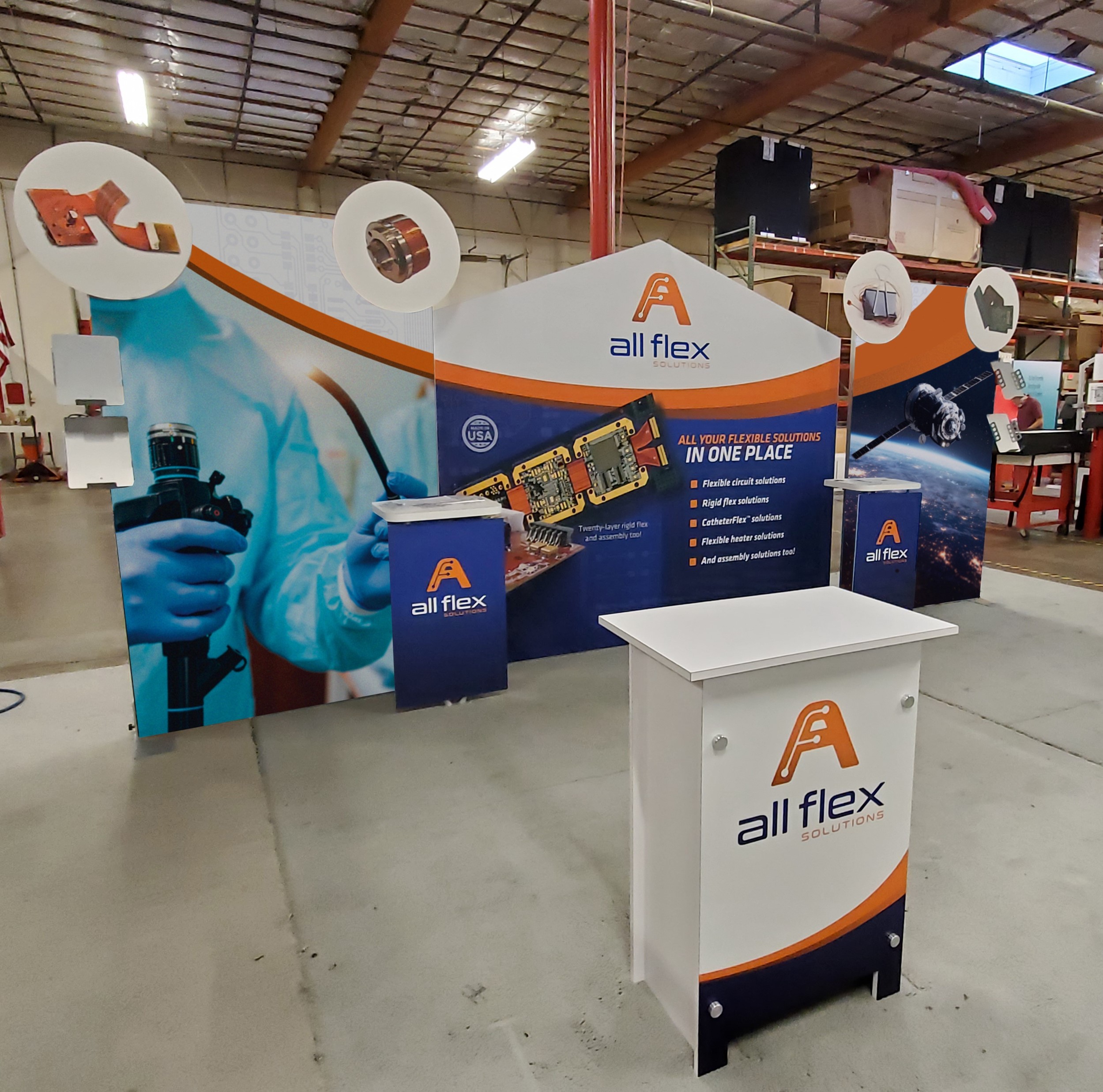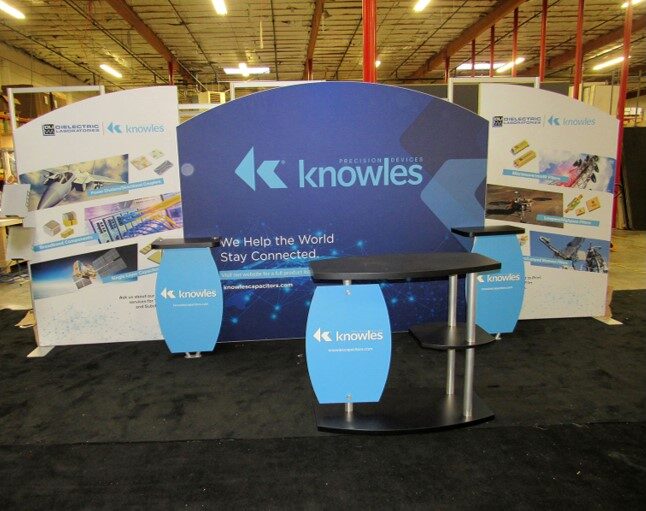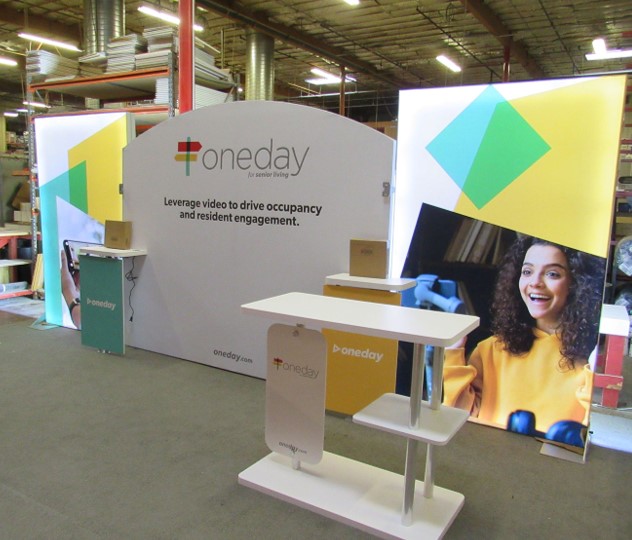You decided on your new trade show display . . . but you’re not done yet. Now, it’s time to design the signage. Every day we see completed trade show printing and signage, many of which we feature on our website. Some amaze us. Others not so much. Obviously, you want AMAZING signage! Here are tips to consider when designing your next trade show banners, signs, and graphics.
Getting Started with Trade Show Printing
Over the years, trade show printing and signage have changed dramatically. Not so long ago, laminates and direct print graphics were the default choice. Now, large print fabric graphics, either dye-sublimated or direct print on fabric, represent 80-90% of all graphics on the show floor.
Not only has the type of signage changed, but so has the technology. The color vibrancy and clarity have improved with newer printing devices like dye sublimation. Fabric signage is lighter, more durable, and easier to install than direct print graphics on Sintra or other foam-based materials. The purchase cost is comparable, and the shipping expense is less expensive.
Then there’s backlighting. The introduction of LED lights and fabric signage made it easy. Booths of every size and shape now include some backlit fabric graphics. Often multiple examples like towers, counters, conference rooms, and overhead hanging signs.
Types of Trade Show Sign & Banner Materials
Let’s make this simple. There are really only two types of trade show signage: direct print and fabric. With direct print, think of traditional printing on paper. It’s the same process but for trade shows, the materials are different.
Direct Prints
- Sintra. Sintra is a foam-based product that can be cut to any shape and comes in a range of thicknesses. It’s used primarily at trade shows and events as inserts in counters, modular wall systems, extrusion infills, and accent graphics.
- Fabric. Signage can be printed directly on fabric. It’s an alternative to dye-sublimated fabric graphics, which we’ll discuss later.
- Vinyl. Trade show banner signs are commonly printed on vinyl because they’re flexible, durable, and inexpensive. In addition, vinyl with adhesive backing is often used as a surface graphic for counters, workstations, charging pedestals, and even as a visual accent on laminated walls.
Fabric Signage
The types of fabric available for trade shows include heavy knits, mesh, sheers, and everything in between. With fabric graphics, you don’t need to worry about dealing with reflections as there is no glass or plastic over your graphic. Printers typically have a range of fabrics available depending on the application. For example:
- Stretch. Some frames, especially portable displays and overhead signs are perfect for stretch fabrics since the final sizing is more forgiving.
- Non-backlit. SEG fabric applications, where silicone welting is sewn to the perimeter, typically specify a material with minimal stretch and internal blocking. The blocking prevents lights from behind the display distorting the images.
- Backlit. Backlit fabric comes in a variety of weights and stretches. Choosing the right one depends on the size of the frame, the application, and the exhibitor’s budget.
- Blocker. This fabric has one job. Serve as a reflector in a lightbox to maximize the brightness of a backlit graphic.
The Dye-Sublimation Process
Dye sublimation, or dye-sub, is printed on paper as a mirror image. If you’ve ever witnessed this process, you know the paper image is subdued and the colors muted. That’s OK. The magic happens in the next step. The printed paper is then run through the sublimation press.
The sublimation press transfers the paper graphic, via rollers, to the transfer fabric. The paper along with the fabric passes at a very slow speed and a very hot temperature. As they pass close to one another, the “solid” ink instantly skips from a liquid into a gas and literally impregnates or dyes the fabric. The vivid color jumps to life and the print replicates the original digital design.
5 Explanations of Eye-Catching Trade Show Signage
Below are 5 examples of trade show graphics on modular inline displays. Modular inlines with separate frames, like the Symphony designs in these examples, can be especially challenging for graphic designers since the images must work both independently and collectively to communicate a cohesive message. Note how the both the graphics and the frames create the themes and branding on these displays.
Exhibit #1

- Contrast between mountain photo and solid colors
- Faded photo in center guides the eye to the logo
- Floating Graphics Reiterate Messaging
- Center panel is stepped forward into the footprint
- Left & right panels curve toward the center panel
- Logo is reinforced on kiosk and reception counter graphics
Exhibit #2

- Logo placed on white center panel w/ otherwise darker elements gives it visual prominence
- Orange band ties all 3 frames together & guides your eye across the display and creates visual motion
- Curves of the band mimic the flexibility of products shown
- Computer chip is angled in the same direction of the orange line reinforcing the curve’s motion
- Floating graphic product photos are magnified and layered over industry products that they are used to build to help define the company’s offerings
- Peaked center panel visually plays off the A in brand
- Floating graphics are removable
Exhibit #3

- Vibrant blue center panel stands out w/ white side panels
- Photos on left and right slant toward center
- Arrows on top right of center panel point to the logo
- Solid cyan graphics w/ logos on kiosks & reception counter contrast w/ backwall panels
- Center frame is stepped forward into the footprint creating brand hierarchy over services on sides
Exhibit #4

- Black and white photos contrast w/ solid blue logo center panel
- Center ghosted lion icon mimics the lion’s gaze in the photo
- Taglines on side panels are lower than logo thus less important
- Center frame is stepped forward & overlaps left and right panels giving it more prominence
- Left and right panels curve toward the center brand panel
Exhibit #5

- Colorful backlit left and right graphics give a fun pop of saturated color and frame the center panel
- Great contrast of clean white center w/ left & right panels
- Angled graphic elements draw your eye to the logo in the center
- Photo of model creates a fun, inviting atmosphere
- Backwall Kiosks add opportunities for additional pops of color
Designing & Printing Tips for Display Signs
1. Up Here.
Think about what elements you want to be seen either 6 ft. away or across the show floor. Avoid putting important elements at floor level. Higher elements will draw your customer’s attention. Those should be the ones you emphasize.
2. Hire a Graphic Designer Who Understands Trade Show Printing and Signage.
A professional graphic designer will know how to source quality files, format them, design your signage, and hit your deadline. If you don’t know what resolution, PMS color, vector art, and bleed are, trust me, you don’t want to be responsible for file preparation. Hire someone who knows what they’re doing.
3. Your Display isn’t a Paper Brochure.
You want your signage to be clear, concise, and to the point. Keep it simple and impactful. Get the help of a copywriter if you can. Avoid clichés and tired expressions like “innovative” and “unique.” Get to the root of the problem and state your solution.
4. Image Quality Counts.
Photos should be high-resolution or vector, especially for your logo. This is critical! Spend the extra money to get good quality stock photography. It’s not that expensive and can make a HUGE difference in your booth.
5. The Devil is in the Details.
View your signage rendered on the display. Sometimes elements of the physical booth really have an effect on the flow of your graphics. You won’t know until you see them. Know where accessories like shelves and monitors are placed. Too many times the graphics arrive and they look amazing… until you realize that the monitor cuts off half of your logo.
6. Create a Flow.
Make sure your graphics tell a coherent story. Make sure that the color scheme and design as well as your copy works together. Don’t reinvent the wheel with each panel. You want the overall design to work together — not confuse.
7. Color is Your Friend . . . or Your Enemy.
Reference specific Pantone swatches when color matching is critical. This goes back to working with a professional when possible. Trade shows are notorious for being tight-turn projects. No one wants to have signage shipped directly to the show only to find out that the nice mustard yellow they were expecting printed peach or pea green.
8. Don’t Font It Up.
One or two fonts are enough. Any more than that and you’ve got an identity crisis. Look for a clean, easy-to-read type, and then if you want a little flare, add an accent font that is more unique, but don’t overuse it.
9. Scale is Everything.
You have the opportunity to create graphics of a larger-than-life magnitude. Seize the day! Go big or go home. Don’t waste your time designing 20-foot graphics that are only meant to be viewed from two feet away. Show them something that makes them want to visit you.
Choose ENW for All Your Trade Show Printing Needs!
Signage is often the most confusing and complicated part of purchasing an exhibit. You can’t know everything about trade shows. Fortunately, the professionals at Exhibits NW have over twenty years of experience designing, building, shipping, and storing trade show displays. We’ll guide you through the nuances of the best trade show signage for your exhibit. If you want your new exhibit to impress trade show attendees and draw crowds to your booth, then contact the team at Exhibits NW.
